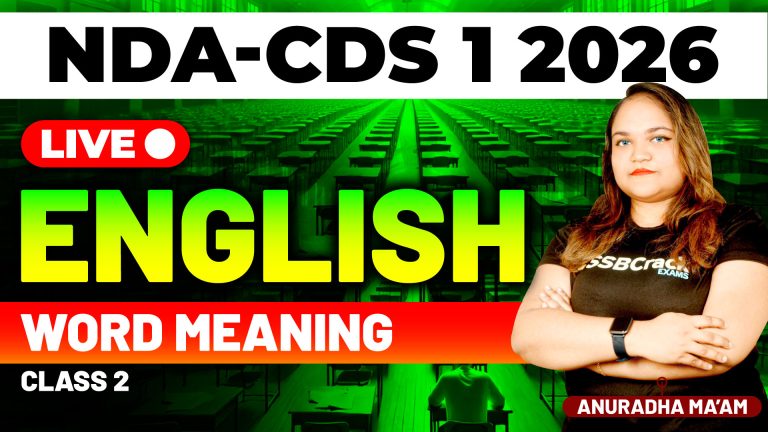Geometry is a foundational topic in the CDS Maths exam, challenging candidates to demonstrate their understanding of shapes, angles, lines, and theorems through a variety of problem types. Recently, a class focused on MCQ practice based on Geometry, reviewing previously covered topics in a way that aligns with the exam format. This session not only reinforced essential geometric concepts but also highlighted effective strategies for solving geometry problems efficiently under exam conditions. Here, we’ll dive into the class content and share tips to prepare effectively for the geometry portion of the CDS exam.
Topics Covered in Class
The class covered a comprehensive range of geometric topics, consolidating knowledge in areas like lines, angles, triangles, circles, and quadrilaterals. Here’s a breakdown of key concepts practiced in MCQs:
- Lines and Angles: The fundamental elements of geometry, lines and angles form the basis of many geometric problems. This section focused on intersecting and parallel lines, properties of transversals, and angle relationships like corresponding and alternate angles. These relationships form the foundation for understanding more complex shapes and constructions, making them essential for the CDS exam.
- Triangles: Triangles are highly emphasized in the CDS syllabus due to their diverse properties and numerous theorems. The class reviewed the properties of triangles, including types based on side lengths (like equilateral, isosceles, and scalene) and angles (acute, obtuse, and right-angled). The focus was also on internal elements of triangles, such as centroids, incenters, circumcenters, and orthocenters. Students practiced identifying these points and using them to solve questions on triangle similarity, congruence, and proportionality theorems.
- Circles: Circles and their related concepts form a major part of geometry questions. Topics discussed included important theorems related to tangents, secants, chords, and the relationship between angles formed inside and outside the circle. Special attention was given to MCQs involving properties like the angle subtended by an arc at the center and the length of tangents drawn from an external point, which frequently appear in the CDS exam.
- Quadrilaterals and Polygons: Quadrilaterals like parallelograms, rectangles, squares, and rhombuses were reviewed, emphasizing properties such as angle sums, parallel sides, and diagonals. In addition, questions on polygons, especially regular polygons, covered topics like the calculation of internal and external angles. Understanding the unique properties of each shape helps in quickly identifying the right approach to solve each question.
- Theorems and Concepts: The class also focused on crucial theorems, including the Pythagorean theorem, basic proportionality theorem, and angle bisector theorem. Practicing these theorems helps candidates develop an intuitive understanding of geometry that can be applied in diverse problem contexts, whether it involves a simple figure or a combination of shapes.
Key Strategies for Preparing Geometry for the CDS Exam
- Focus on Theorems and Properties
Geometry in competitive exams relies heavily on the application of fundamental theorems and shape properties. Rather than memorizing these properties, aim to understand why they hold true. This understanding helps in tackling variations of problems that may seem unfamiliar at first but are solvable by applying basic geometric principles. Start by practicing simpler applications, then work up to more complex questions involving multiple steps. - Practice MCQs Regularly
Geometry questions in the CDS exam are often conceptual and require accuracy. By practicing MCQs from past exams and similar sources, you can familiarize yourself with the question format, typical traps, and the most efficient solutions. Timed practice sessions are particularly helpful, as they simulate the exam environment and improve your speed in selecting the correct answer. - Utilize Visual Aids
Drawing diagrams for geometry problems is essential, especially when dealing with unknowns or complex shapes. Accurate sketches provide a clear visualization of the relationships within a problem, making it easier to identify relevant angles, lengths, and other characteristics. Whenever faced with a difficult geometry problem, take a moment to create a labeled diagram; it often leads to quicker and more accurate solutions. - Review Mistakes and Learn from Them
When practicing MCQs, take note of any mistakes you make and analyze why they occurred. Geometry questions can sometimes lead to minor errors in reasoning or diagram interpretation. By reviewing these mistakes, you build awareness of common pitfalls and strengthen your understanding of concepts. Maintain a list of questions you struggled with, and periodically review them to ensure you don’t repeat similar errors. - Master Basic Proportionality and Similarity Concepts
Similarity and proportionality are crucial for solving complex geometry questions involving triangles and other polygons. Make sure you are comfortable with the proportionality theorem and can identify when two triangles are similar. Practicing questions involving similarity ratios, parallel lines, and triangle properties will be invaluable, as these often form the basis of more advanced questions. - Leverage Mock Tests and Previous Year Papers
Practicing mock tests and previous year papers gives insight into the geometry questions likely to appear on the CDS exam. Pay attention to question patterns, frequently tested topics, and the difficulty level. Attempting these papers under timed conditions can also help you manage your time effectively in the actual exam. - Build Confidence with Circle Theorems
Questions involving circles are often among the more challenging in the geometry section. Focus on mastering circle theorems related to tangents, chords, and angles. Understand properties like the equal length of tangents from an external point, angles in a semi-circle, and relationships between intersecting chords. A solid grasp of these theorems will make it easier to solve even the most complex circle-related questions. - Maintain a Problem-Solving Approach
Instead of immediately diving into calculations, approach each question with a clear plan. Start by identifying what the question is asking, what information is provided, and which geometric principles apply. Adopting a problem-solving approach helps avoid unnecessary steps and keeps you focused on reaching the solution logically and efficiently.
Conclusion
Geometry can be one of the most rewarding yet challenging sections of the CDS Maths exam. By practicing MCQs, mastering essential theorems, and maintaining a clear problem-solving approach, candidates can enhance their speed and accuracy in tackling these questions. This recent class emphasized the importance of understanding basic principles and applying them effectively, an approach that will undoubtedly benefit students as they continue their CDS preparation.
To succeed in geometry on the CDS exam, remember to practice consistently, visualize problems through diagrams, and focus on learning from your mistakes. With dedicated preparation and a strategic approach, mastering geometry becomes manageable and can significantly contribute to a strong performance on exam day.

















